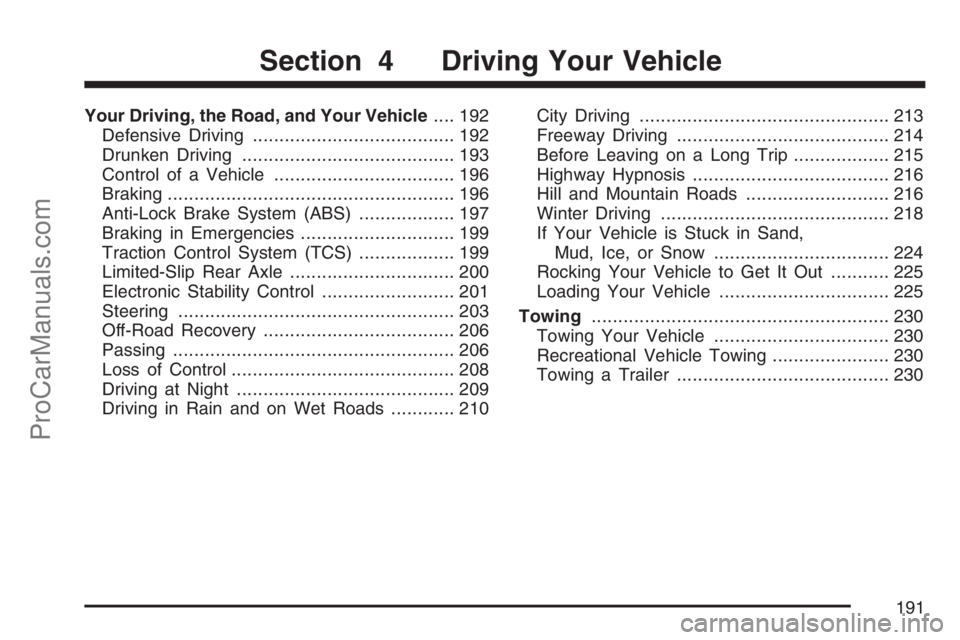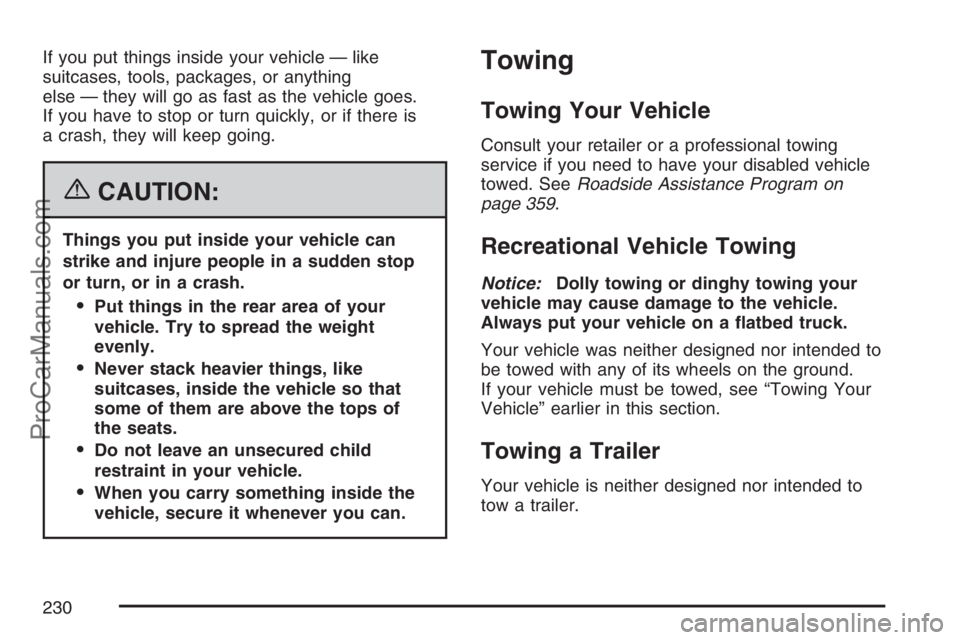2007 SATURN SKY tow
[x] Cancel search: towPage 112 of 384

Turn and Lane-Change Signals
The turn signal has two upward (for right) and
two downward (for left) positions. These positions
allow you to signal a turn or a lane change.
To signal a turn, move the lever all the way up or
down. When the turn is �nished, the lever will
return automatically.
An arrow on the
instrument panel cluster
will �ash in the
direction of the turn or
lane change.
To signal a lane change, raise or lower the lever
until the arrow starts to �ash. Hold it there until you
complete your lane change. The lever will return
by itself when you release it.
As you signal a turn or a lane change, if the arrows
�ash rapidly, a signal bulb may be burned out and
other drivers will not see your turn signal. If a bulb is
burned out, replace it to help avoid an accident.
If the arrows do not go on at all when you signal a
turn, check the fuse. SeeFuses and Circuit
Breakers on page 325.
Headlamp High/Low-Beam Changer
To change the headlamps from low beam to high
beam, push the turn signal lever away from you.
When the high beams
are on, this light on the
instrument panel
cluster will also be on.
To change the headlamps from high beam to low
beam, pull the turn signal lever toward you.
Flash-to-Pass
This feature lets you use your high-beam
headlamps to signal a driver in front of you that
you want to pass.
To use it, pull the turn signal/multifunction lever
toward you until the high-beam headlamps
come on, then release the lever to turn them off.
112
ProCarManuals.com
Page 134 of 384

Brake System Warning Light
Your vehicle’s hydraulic brake system is divided
into two parts. If one part is not working, the other
part can still work and stop you. For good
braking, though, you need both parts working well.
If the warning light comes on, there is a brake
problem. Have your brake system inspected
right away.
This light should come on brie�y when you turn
the ignition key to RUN. If it does not come
on then, have it �xed so it will be ready to warn
you if there is a problem.When the ignition is on, the brake system warning
light will also come on when you set your
parking brake. The light will stay on if your parking
brake does not release fully. If it stays on after
your parking brake is fully released, it means you
have a brake problem.
If the light comes on while you are driving, pull off
the road and stop carefully. Make sure the parking
brake is fully released. You may notice that the
pedal is harder to push or, the pedal may go closer
to the �oor. It may take longer to stop. If the light is
still on, have the vehicle towed for service. See
Towing Your Vehicle on page 230.
{CAUTION:
Your brake system may not be working
properly if the brake system warning light
is on. Driving with the brake system
warning light on can lead to an accident.
If the light is still on after you have pulled
off the road and stopped carefully, have
the vehicle towed for service.
United StatesCanada
134
ProCarManuals.com
Page 191 of 384

Your Driving, the Road, and Your Vehicle.... 192
Defensive Driving...................................... 192
Drunken Driving........................................ 193
Control of a Vehicle.................................. 196
Braking...................................................... 196
Anti-Lock Brake System (ABS).................. 197
Braking in Emergencies............................. 199
Traction Control System (TCS).................. 199
Limited-Slip Rear Axle............................... 200
Electronic Stability Control......................... 201
Steering.................................................... 203
Off-Road Recovery.................................... 206
Passing..................................................... 206
Loss of Control.......................................... 208
Driving at Night......................................... 209
Driving in Rain and on Wet Roads............ 210City Driving............................................... 213
Freeway Driving........................................ 214
Before Leaving on a Long Trip.................. 215
Highway Hypnosis..................................... 216
Hill and Mountain Roads........................... 216
Winter Driving........................................... 218
If Your Vehicle is Stuck in Sand,
Mud, Ice, or Snow ................................. 224
Rocking Your Vehicle to Get It Out........... 225
Loading Your Vehicle................................ 225
Towing........................................................ 230
Towing Your Vehicle ................................. 230
Recreational Vehicle Towing...................... 230
Towing a Trailer........................................ 230
Section 4 Driving Your Vehicle
191
ProCarManuals.com
Page 225 of 384

Rocking Your Vehicle to Get It Out
First, turn the steering wheel left and right.
That will clear the area around the front wheels.
If your vehicle has traction control, you should
turn the traction control system off. SeeTraction
Control System (TCS) on page 199andElectronic
Stability Control on page 201. Then shift back
and forth between REVERSE (R) and a forward
gear, or with a manual transmission between
FIRST (1) or SECOND (2) and REVERSE (R),
spinning the wheels as little as possible.
To prevent transmission wear, allow the wheels
to stop spinning before shifting gears. Release
the accelerator pedal while you shift, and
press lightly on the accelerator pedal when the
transmission is in gear. By slowly spinning
the wheels in the forward and reverse directions,
you will cause a rocking motion that may free
your vehicle. If that does not get your vehicle
out after a few tries, it may need to be towed out.
If your vehicle does need to be towed out, see
Towing Your Vehicle on page 230.
Loading Your Vehicle
It is very important to know how much weight
your vehicle can carry. This weight is called
the vehicle capacity weight and includes the
weight of all occupants, cargo, and all
nonfactory-installed options. Two labels on your
vehicle show how much weight it may properly
carry, the Tire and Loading Information label
and the Certi�cation label.
{CAUTION:
Do not load your vehicle any heavier than
the Gross Vehicle Weight Rating (GVWR),
or either the maximum front or rear Gross
Axle Weight Rating (GAWR). If you do,
parts on your vehicle can break, and it
can change the way your vehicle handles.
These could cause you to lose control
and crash. Also, overloading can shorten
the life of your vehicle.
225
ProCarManuals.com
Page 227 of 384

4. The resulting �gure equals the available
amount of cargo and luggage load capacity.
For example, if the “XXX” amount equals
1400 lbs and there will be �ve 150 lb
passengers in your vehicle, the amount of
available cargo and luggage load capacity is
650 lbs (1400−750 (5 x 150) = 650 lbs).
5. Determine the combined weight of luggage
and cargo being loaded on the vehicle. That
weight may not safely exceed the available
cargo and luggage load capacity calculated
in Step 4.
6. If your vehicle will be towing a trailer, the load
from your trailer will be transferred to your
vehicle. Consult this manual to determine how
this reduces the available cargo and luggage
load capacity of your vehicle.
Your vehicle is neither designed nor intended
to tow a trailer.
Item Description Total
AVehicle Capacity
Weight for Example 1=400 lbs (181 kg)
BSubtract Occupant
Weight @ 150 lbs
(68 kg) x 1 =150 lbs (68 kg)
CAvailable Occupant
and Cargo Weight =250 lbs (113 kg) Example 1
227
ProCarManuals.com
Page 230 of 384

If you put things inside your vehicle — like
suitcases, tools, packages, or anything
else — they will go as fast as the vehicle goes.
If you have to stop or turn quickly, or if there is
a crash, they will keep going.
{CAUTION:
Things you put inside your vehicle can
strike and injure people in a sudden stop
or turn, or in a crash.
Put things in the rear area of your
vehicle. Try to spread the weight
evenly.
Never stack heavier things, like
suitcases, inside the vehicle so that
some of them are above the tops of
the seats.
Do not leave an unsecured child
restraint in your vehicle.
When you carry something inside the
vehicle, secure it whenever you can.
Towing
Towing Your Vehicle
Consult your retailer or a professional towing
service if you need to have your disabled vehicle
towed. SeeRoadside Assistance Program on
page 359.
Recreational Vehicle Towing
Notice:Dolly towing or dinghy towing your
vehicle may cause damage to the vehicle.
Always put your vehicle on a �atbed truck.
Your vehicle was neither designed nor intended to
be towed with any of its wheels on the ground.
If your vehicle must be towed, see “Towing Your
Vehicle” earlier in this section.
Towing a Trailer
Your vehicle is neither designed nor intended to
tow a trailer.
230
ProCarManuals.com
Page 245 of 384

A. Windshield Washer Fluid Reservoir. See
“Adding Washer Fluid” underWindshield
Washer Fluid on page 267.
B. Coolant Surge Tank and Pressure Cap.
SeeCooling System on page 260.
C. Brake Master Cylinder Reservoir. See
“Brake Fluid” underBrakes on page 268
andHydraulic Clutch on page 254.
D. Engine Oil Dipstick. See “Checking Engine
Oil” underEngine Oil on page 245.
E. Engine Air Cleaner/Filter. SeeEngine
Air Cleaner/Filter on page 252.
F. Engine Oil Fill Cap. See “When to Add
Engine Oil” underEngine Oil on page 245.
G. Power Steering Fluid Reservoir. See
Power Steering Fluid on page 266.
H. Remote Negative (−) Ground (Out of View).
SeeJump Starting on page 272.
I. Battery (Out of View). SeeBattery on page 271.
J. Remote Positive (+) Terminal. SeeJump
Starting on page 272.
K. Underhood Fuse Block. SeeUnderhood
Fuse Block on page 328.Engine Oil
Checking Engine Oil
It is a good idea to check the engine oil every time
you get fuel. In order to get an accurate reading,
the oil must be warm and the vehicle must be
on level ground.
The engine oil dipstick handle is a yellow loop.
SeeEngine Compartment Overview on page 242
for the location of the engine oil dipstick.
1. Turn off the engine and give the oil several
minutes to drain back into the oil pan. If you
do not do this, the oil dipstick might not
show the actual level.
2. Pull the dipstick and clean it with a paper
towel or cloth, then push it back in all the
way. Remove it again, keeping the tip down
and check the level.
245
ProCarManuals.com
Page 295 of 384

If your vehicle has Goodyear Eagle F1-GS1
P245/45R18 size tires, they are directional
tires and must roll in a certain direction for the
best overall performance. The direction is shown
by an arrow on the tire sidewall. Because
these tires are directional, they should be rotated
as shown here. These tires should only be
moved from front to rear and rear to front on
the same side of the vehicle.After the tires have been rotated, adjust the front
and rear in�ation pressures as shown on the
Tire and Loading Information label. SeeLoading
Your Vehicle on page 225for an example of
the Tire and Loading Information label and
its location on your vehicle. Make certain that all
wheel nuts are properly tightened. See “Wheel
Nut Torque” underCapacities and Speci�cations
on page 331.
{CAUTION:
Rust or dirt on a wheel, or on the parts to
which it is fastened, can make wheel nuts
become loose after a time. The wheel could
come off and cause a crash. When you
change a wheel, remove any rust or dirt
from places where the wheel attaches to
the vehicle. In an emergency, you can use
a cloth or a paper towel to do this; but be
sure to use a scraper or wire brush later,
if you need to, to get all the rust or dirt off.Directional Tires
295
ProCarManuals.com